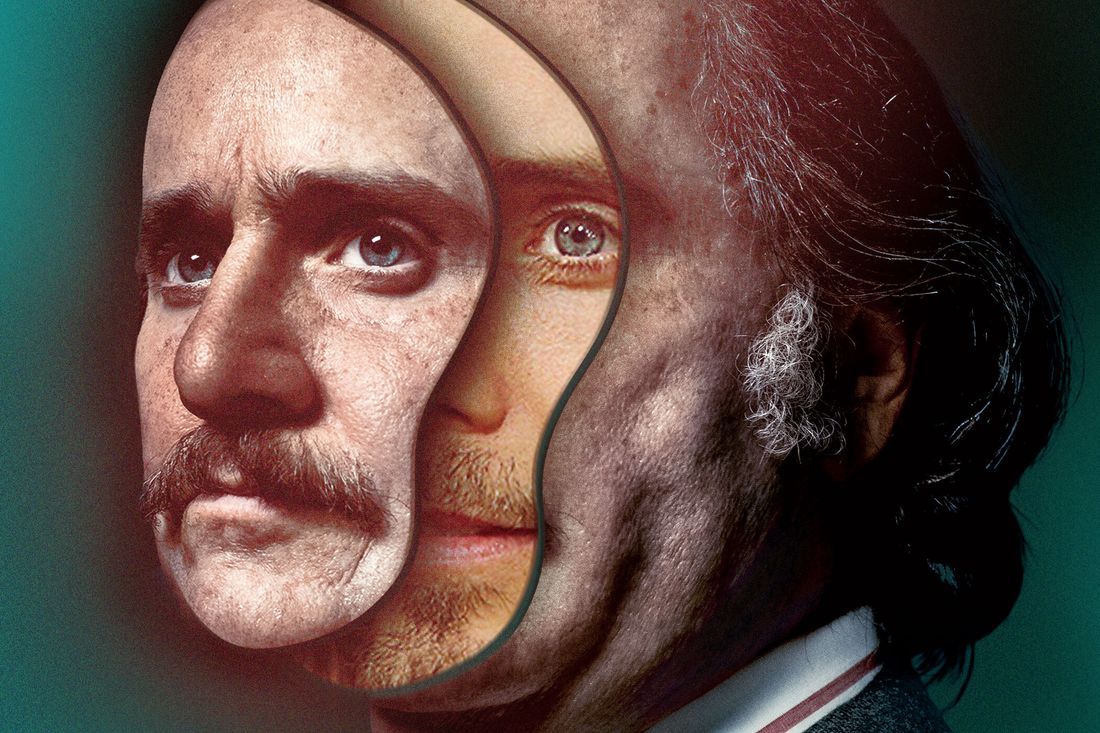
Acting is about transformation both psychological and physical. When it comes to the showiest efforts, it’s mostly the latter that comes to mind. Gaining weight, losing weight, packing on muscle, shaving off hair — in the most extreme examples, the oblations that actors undertake for their craft can serve as press-baiting stunts. You might think of these rituals as just another aspect of preparation along the lines of shadowing someone in the field or learning fight choreography. The actor’s body is, after all, a tool of performance, one that can be trained and molded for a part.
And then there’s the kind of transformation that requires latex. It’s considered a compliment to any prestige film or series if an actor is called “unrecognizable” — an effect achieved through makeup, costume, and, most drastically, prosthetics. And this season’s offerings are full of that last one: There’s Jessica Chastain, “unrecognizable” as Tammy Faye Bakker in The Eyes of Tammy Faye. There’s false-toothed Sarah Paulson as Linda Tripp in Impeachment: American Crime Story. The recent trailer for Being the Ricardos, out December 10, revealed a becheeked Nicole Kidman, turned just a little alien in an effort to make her look like Lucille Ball. And reigning over them all is Jared Leto in Ridley Scott’s House of Gucci. To play Paolo Gucci, a man who enraged his family by launching his own Gucci-branded business before getting his father ousted from the company and sent to jail for tax evasion, Leto dons a bald cap and much more, his eyes peering out from behind a newly acquired bulbous nose, plumped-up cheeks, and a double chin.
Watching the long-locked part-time rock god pretend to be the chrome-domed fashion failson is enough to make anyone meditate on the strangeness of Hollywood’s prosthetics habit. Not the sort used to turn an actor into a monster or the recent recipient of a head wound — in the tradition of Lon Chaney a near century ago in The Phantom of the Opera, warping his own nose by sticking wires in his nostrils — but the kind used to make them look like a person who actually existed by way of fat suits and synthetic jowls. There is something so old-fashioned about it, so labored, so stagecraft. It’s a glaring reminder that despite how it’s often discussed, acting isn’t always some alchemical process involving the mysteries of an interior landscape. Per Laurence Olivier, a man who knew his way around a fake nose, it’s also “the business of showing off.”
These inspired-by-real-life prosthetics are meant to bring authenticity, but they have a perverse way of achieving the opposite. Leto has a history of going to great lengths for his roles: He put on nearly 70 pounds for Chapter 27. He got most of his body waxed for Dallas Buyers Club. His new look as Paolo Gucci seems to have freed him up enough to out-clown his own take on the Joker, including an accent best summed up as “the full Super Mario.” It’s the kind of performance that gets described as “fun,” though it’s unclear whether it’s the audience or the actor who is meant to be enjoying it. There are plenty of actors out there who manage to be thinning on top and thick around the jaw without help. It’s just that few of them have Leto’s hoped-for box-office allure. When we praise an actor by saying they’ve become unrecognizable, we’re implying they’re usually very recognizable — it’s not an achievement worth calling out if no one knows what you look like in the first place. It’s an odd compliment for an actor anyway, as though their greatest feats involved not building a character but erasing themselves from view.
At least in House of Gucci, excess, rather than realism, is the point. In The Eyes of Tammy Faye, Chastain adopts the disgraced televangelist’s tarantula-like mascara and hard-line eyebrows as well as prosthetics that round out her lower face, but she never really finds the real woman under all the trappings. Playing people as heavily televised as Bakker and Ball seems to make prosthetic tweaks irresistible, yet the result usually lands the actor in the uncanny valley of overly literal biopics — reminiscent of when Charlize Theron got plugs in her nose to make it more closely resemble Megyn Kelly’s for Bombshell and ended up looking neither like herself nor her subject.
To focus the rigors of an actor’s impression is to direct attention away from the choices that have to be made in bringing a life to screen. Like many similar projects, The Eyes of Tammy Faye concludes with images of the real people, in its case a clip of Chastain in character alongside footage of the actual Bakker, the two delivering the same line almost in unison. This sort of coda is intended to stress how close the performance came to replicating reality — though even the most researched of these movies are, at best, inspired by the truth. They’re working in the service of a story. Doing that means eliding inconvenient facts, truncating messy developments, leaning into fiction to bridge gaps. It means privileging some perspectives and discarding others. The viewer gets this. So why insist on comparing the fake to the original?
Maybe it’s just easier to talk about an actor’s physical transformation than it is to ask why we care so much about the illusion of historical accuracy. Or at least it used to be. The blowback Paulson got over the fat suit she wears as Tripp in Impeachment led her to admit to the Los Angeles Times that when she considers what she went through for the part, she regrets “not thinking about it more fully.” These transformations do seem to only ever go in one direction, with light-skinned, thin, able-bodied, conventionally attractive performers making themselves look otherwise for a part before returning to the privileges of their status quo once the job is over. What’s considered permissible to play a part is under constant reassessment — consider the not-so-distant history of blackface and yellowface. The question here is whether we value acting over imitation.
It’s no accident that one of the most-talked-about performances this fall involves an actress who doesn’t particularly look like the famous figure she is playing. The film Spencer is billed as a “fable from a true tragedy,” clearing space to play around with fiction inside the basic outlines of fact. Kristen Stewart, as Princess Diana, doesn’t try to replicate her so much as offer an interpretation. Stewart’s jawline is different from Diana’s. She is five inches shorter. Her eyes are green instead of blue. And none of that matters because Stewart is so clearly meant to be playing a character. To try to re-create the face of one of the most photographed women in the world would be futile and distracting. Spencer’s Diana, who is experiencing something close to a breakdown over a suffocating Christmas holiday toward the end of her marriage, comes to life unconstrained by chin padding. We’re aware that this is a version of the princess as dreamed up by screenwriter Steven Knight and director Pablo Larraín, one with an inner life that has been imagined, even as her surroundings are grounded in real details.
There’s an innate absurdity to acting. Prosthetics can bring that out — but they can also be a buffer, a protective veil between actor and audience. Olivier, who often sought out what he referred to as “the protective shelter of nose-putty,” recounted in his 1982 autobiography that when he was 16, a drama-and-voice teacher slid her finger down the center of his forehead until it rested on the top of his schnoz, where she informed him he had “weakness.” Whether she was diagnosing a deficiency in spirit or nasal contours, Olivier would spend the rest of his legendary career feeling relieved whenever a role allowed him to make additions to his face, so as to “avoid anything so embarrassing as self-representation.” Maybe that’s the real benefit to making yourself unrecognizable: It’s less an act of artistic devotion than one of self-protection — a way to go unseen even when you’re onscreen.





